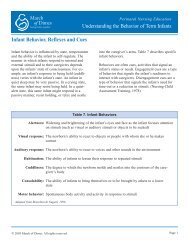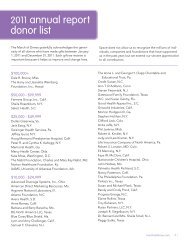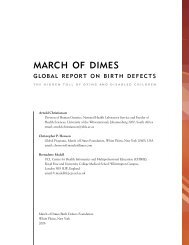Ob Gyn Quality Indicators… - March of Dimes
Ob Gyn Quality Indicators… - March of Dimes
Ob Gyn Quality Indicators… - March of Dimes
Create successful ePaper yourself
Turn your PDF publications into a flip-book with our unique Google optimized e-Paper software.
LEADING THE QUEST FOR HEALTH <br />
<strong>Ob</strong> <strong>Gyn</strong> <strong>Quality</strong> <strong>Indicators…</strong><br />
What are they and who cares?<br />
Kimberly D. Gregory MD, MPH<br />
Vice Chair Women’s Healthcare <strong>Quality</strong> & Performance Improvement<br />
Department <strong>Ob</strong>stetrics & <strong>Gyn</strong>ecology<br />
Cedars Sinai Medical Center<br />
Pr<strong>of</strong>essor, David Geffen School <strong>of</strong> Medicine &<br />
UCLA School <strong>of</strong> Public Health
Disclosures<br />
I have no financial disclosures<br />
No <strong>of</strong>f label use <strong>of</strong> medications
<strong>Ob</strong>jectives<br />
At the completion <strong>of</strong> this lecture, participant will<br />
be able to<br />
1. Define quality <strong>of</strong> care<br />
2. Identify quality indicators used in women’s health<br />
3. Be familiar with external entities charged with<br />
developing indicators, monitoring and reporting<br />
results<br />
4. Be familiar with strengths and limitations <strong>of</strong><br />
available indicators
What is quality?<br />
“that kind <strong>of</strong> care which is expected to<br />
maximize a measure <strong>of</strong> patient welfare,<br />
after one has taken account <strong>of</strong> the<br />
balance <strong>of</strong> expected gains and losses that<br />
attend the process <strong>of</strong> care in all its parts”<br />
—Donabedian, 1980
What is <strong>Quality</strong>?<br />
High quality care “consistently contributes to the improvement<br />
or maintenance <strong>of</strong> quality and/or duration <strong>of</strong> life<br />
Delineated attributes <strong>of</strong> care that defined quality<br />
— Emphasis on health promotion and disease prevention<br />
— Timeliness<br />
— Informed participation <strong>of</strong> patients<br />
— Attention to scientific basis <strong>of</strong> medicine<br />
— Efficient use <strong>of</strong> resources<br />
American Medical Association, 1984
What is <strong>Quality</strong>?<br />
“Degree to which health services for individuals<br />
and populations increase the likelihood <strong>of</strong><br />
desired health outcomes and are consistent<br />
with current pr<strong>of</strong>essional knowledge”<br />
—Institute <strong>of</strong> Medicine, 1990
health services<br />
— all encompassing<br />
<strong>Quality</strong> Health Care: IOM<br />
— (services: acute, long term, prevention,<br />
promotion; any provider; across all settings)<br />
— patient focused, provider focused, organization<br />
focused<br />
individuals & populations<br />
— applies to individuals, clinicians, institutions,<br />
health plans, and health systems<br />
— different perspectives, stakeholders
<strong>Quality</strong> Health Care: IOM<br />
desired health outcomes<br />
— link between care, outcome (effects on health),<br />
and patient expectations<br />
— implies patient education, participation<br />
increase the likelihood<br />
— good outcome is not guaranteed<br />
poor outcomes occur, despite best possible care<br />
patients do well despite poor quality<br />
— assessing quality requires attention to both<br />
process and outcome
<strong>Quality</strong> Health Care: IOM<br />
consistent with current knowledge<br />
— dynamic, evolving knowledge base<br />
— willing to revise as new knowledge becomes<br />
available
Health Care <strong>Quality</strong>: IOM definition <strong>of</strong> poor quality<br />
Underuse: failure to provide a health service<br />
when it would have produced a favorable<br />
outcome<br />
Overuse: service provided and potential for<br />
harm exceeds the possible benefit<br />
Misuse: appropriate service but a<br />
preventable complication<br />
— “consistency in process” is a pillar <strong>of</strong> quality -<br />
Donabedian
Summary <strong>of</strong> the Essence <strong>of</strong> <strong>Quality</strong><br />
Doing the right thing, the right way, at the<br />
right time!
Donabedian: Concepts Important<br />
for<br />
<strong>Quality</strong> Measurement<br />
Structure: attributes <strong>of</strong> the patient<br />
or health care entity<br />
Process: events or<br />
procedures that happen to<br />
the patient<br />
Outcome: survival, complications,<br />
quality <strong>of</strong> life<br />
Must be able to measure to improve
Healthcare <strong>Quality</strong>—Who Cares?
Healthcare <strong>Quality</strong>—Who Cares?<br />
ACOG WEBTREATS: Performance Measures and<br />
<strong>Quality</strong> Improvement<br />
—as <strong>of</strong> 3/8/11<br />
—20 different agency sponsored websites<br />
— www.acog.org/departments/dept_notice.cfm?recno=10&bulletin=4226;<br />
accessed 4/8/11<br />
— 21 different sponsored websites; accessed 3/1/2012
Healthcare <strong>Quality</strong>—Why Care?<br />
Depends on perspective (stakeholder)<br />
Physician: to maintain pr<strong>of</strong>essionalism, autonomy<br />
Patient: to be healthy, get a good outcome<br />
Payer: ideal employee outcome; optimal employees outcome<br />
(efficiency/trade<strong>of</strong>f/cost effectiveness)<br />
Assume<br />
— Measure to improve<br />
— Individual standardization maximizes system efficiency
Women’s healthcare<br />
—Broad topic<br />
<strong>Ob</strong>/gyn<br />
What do we measure?<br />
—Disappointing dearth <strong>of</strong> indicators<br />
—4 million births; # 1 cause <strong>of</strong> hospital admission<br />
Comparatively few indicators, relative to general adult<br />
population<br />
—<strong>Gyn</strong> is even more sparse
Healthy People 2020<br />
What do we measure?<br />
National Goals or “indicators” <strong>of</strong> the health <strong>of</strong> the nation<br />
— Family Planning (15)<br />
— Maternal, Infant, & Child health (19)<br />
Morbidity & Mortality<br />
Pregnancy health and behavior<br />
Preconception health and behavior<br />
Postpartum health and behavior<br />
— Sexually Transmitted Infections( 9)
HP 2020: Family Planning<br />
Number <strong>Ob</strong>jective Short Title<br />
FP–1 Intended pregnancy<br />
FP–2 Contraceptive failure<br />
FP–3 Emergency contraception available at family planning clinics<br />
FP–4 Health insurance coverage for contraceptive supplies and services<br />
FP–5 Birth spacing<br />
FP–6 Contraceptive use at most recent sexual intercourse<br />
FP–7 Receipt <strong>of</strong> reproductive health services<br />
FP–8 Adolescent pregnancy<br />
FP–9 Abstinence ages 17 and under<br />
FP–10 Use <strong>of</strong> condoms for pregnancy prevention and protection against<br />
disease<br />
FP–11 Dual method use for pregnancy and disease prevention<br />
FP–12 Adolescent Reproductive health education<br />
FP–13 Parent-adolescent communication about reproductive health topics<br />
FP–14 Medicaid eligibility for pregnancy-related care<br />
FP–15 Receipt <strong>of</strong> publicly supported contraceptive services and supplies
HP 2020: Maternal & Infant Health<br />
Morbidity & Mortality<br />
Number <strong>Ob</strong>jective Short Title<br />
MICH–1 Fetal and infant deaths<br />
MICH–2 Deaths among infants with Down syndrome<br />
MICH–3 Child deaths<br />
MICH–4 Adolescent and young adult deaths<br />
MICH–5 Maternal deaths<br />
MICH–6 Maternal illness and complications due to pregnancy<br />
MICH–7 Cesarean births<br />
MICH–8 Low birth weight and very low birth weight<br />
MICH–9 Preterm births
Healthy People 2020<br />
Description Baseline (2007) Goal<br />
MICH-5 Maternal Mortality 12.7/100k 11.3/100k<br />
MICH-6 Complications L&D 31.1% 28.0%<br />
MICH-7.1 NTSV Cesarean 26.5% 23.9%<br />
MICH-7.2 Prior CS 90.8 87.7
HP2020: Maternal & Infant Health<br />
Pregnancy Health & Behaviors<br />
Number <strong>Ob</strong>jective Short Title<br />
MICH–10 Prenatal care (early & adequate)<br />
MICH–11 Prenatal substance exposure<br />
(decrease)<br />
“Developmental”<br />
MICH–12 Childbirth classes<br />
MICH–13 Weight gain during pregnancy
HP 2020: Maternal & Infant Health<br />
Preconception Health and Behaviors (Developmental)<br />
Number <strong>Ob</strong>jective Short Title<br />
MICH–14 Optimum folic acid levels<br />
MICH–15 Low red blood-cell folate concentrations<br />
MICH–16 Preconception care services and behaviors<br />
MICH–17 Impaired fecundity<br />
Postpartum Health and Behavior (Developmental)<br />
MICH–18 Postpartum relapse <strong>of</strong> smoking<br />
MICH–19 Postpartum care visit with a health worker
HP 2020: Sexually Transmitted Infections<br />
Number <strong>Ob</strong>jective Short Title<br />
STD–1 Chlamydia<br />
STD–2 Chlamydia among females<br />
STD–3 Annual screening for genital Chlamydia by Medicaid<br />
STD–4 Annual screening for genital Chlamydia by insurance plans<br />
STD–5 Pelvic inflammatory disease<br />
STD–6 Gonorrhea<br />
STD–7 Primary and secondary syphilis<br />
STD–8 Congenital syphilis<br />
STD–9 Human papillomavirus infection<br />
STD-10 Congenital herpes<br />
Some NCQA<br />
HEDIS measures
AHRQ <strong>Quality</strong> Indicators<br />
Agency Healthcare Research & <strong>Quality</strong><br />
(AHRQ)<br />
Prevention <strong>Quality</strong> Indicators<br />
Inpatient <strong>Quality</strong> Indicators<br />
Patient Safety Indicators
AHRQ Prevention <strong>Quality</strong> Indicators<br />
“Ambulatory care sensitive conditions”<br />
—Hospital admissions that evidence<br />
suggests could have been avoided<br />
through high quality outpatient care<br />
or that reflect conditions that could be less<br />
severe, if treated early and appropriately<br />
—Represent current state <strong>of</strong> the art in<br />
measuring the outcomes <strong>of</strong> preventive and<br />
outpatient care thru analysis <strong>of</strong> inpatient<br />
discharge data
AHRQ Prevention <strong>Quality</strong> Indicators<br />
16 “ambulatory care sensitive conditions”<br />
Bacterial pneumonia<br />
Dehydration<br />
Pediatric gastroenteritis<br />
UTI<br />
Perforated appendix<br />
Low Birth weight<br />
Angina w/o procedure<br />
CHF<br />
Hypertension<br />
Adult asthma<br />
Pediatric asthma<br />
COPD<br />
Diabetes-short term<br />
Diabetes-long term<br />
Uncontrolled diabetes<br />
Lower extremity amp
AHRQ Prevention <strong>Quality</strong> Indicators<br />
16 “ambulatory care sensitive conditions”<br />
Low Birth weight<br />
Only 1/16 specific to<br />
OB<br />
Additional 8 have<br />
potential applicability<br />
Hypertension<br />
Adult asthma<br />
Bacterial pneumonia<br />
Perforated appendix<br />
UTI<br />
Diabetes-short term<br />
Diabetes-long term<br />
Uncontrolled diabetes
AHRQ Inpatient <strong>Quality</strong> Indicators (29)<br />
Indicators reflect quality <strong>of</strong> care inside hospitals<br />
and include<br />
—Mortality<br />
(13 indicators)<br />
—Utilization <strong>of</strong> procedures for which there are<br />
questions <strong>of</strong> overuse, underuse, or misuse<br />
(9 indicators)<br />
—Volume <strong>of</strong> procedures for which there is<br />
evidence that a higher volume <strong>of</strong> procedures is<br />
associated with lower mortality<br />
(7 indicators)
AHRQ Inpatient <strong>Quality</strong> Indicators<br />
Indicators that reflect quality <strong>of</strong> care inside<br />
hospitals and specific to reproductive<br />
women’s health<br />
Hospital level procedure utilization rates<br />
—CS delivery<br />
—VBAC<br />
Area level procedure utilization rates<br />
—hysterectomy<br />
<strong>Gyn</strong>, OMG!
AHRQ Patient Safety <strong>Quality</strong> Indicators (26)<br />
Indicators reflect quality <strong>of</strong> care inside hospitals,<br />
by focusing on patient safety performance<br />
—Indicators aid in quickly detecting potential<br />
preventable medical errors in patients<br />
undergoing surgery or procedures<br />
20 Hospital level PSI’s<br />
6 Area level PSI’s
Provider-Level Indicators<br />
PSI #1: Rate <strong>of</strong> Complications <strong>of</strong><br />
Anesthesia<br />
AHRQ Patient Safety Indicators<br />
Included in current analysis AHRQ definition includes pregnant<br />
women (MDC 14)<br />
Yes Cesarean and other surgical<br />
procedures only<br />
Reason if not included in the current<br />
analysis<br />
PSI #2: Death in Low Mortality DRGs No Yes Low prevalence; all maternal deaths<br />
should be studied as sentinel events<br />
PSI #3: Pressure ulcer No Yes Not relevant to this population<br />
PSI #4: Death among Surgical<br />
Inpatients with Serious Treatable<br />
Conditions<br />
PSI #5: Foreign Body Left during<br />
Procedure 1<br />
No Select cases only Low prevalence; all maternal deaths<br />
should be studied as sentinel events<br />
Yes Yes<br />
PSI #6: Iatrogenic Pneumothorax 1 No No Not relevant to this population<br />
PSI #7: Central Venous Catheter-<br />
Related Bloodstream Infections*<br />
No Yes Rare in this population<br />
PSI #8: Post-Operative Hip Fracture No No Not relevant to this population<br />
PSI #9: Post-Operative Hemorrhage<br />
or Hematoma 1<br />
Yes No
Provider-Level Indicators<br />
PSI #10: Post-Operative Physiologic<br />
and Metabolic Derangements<br />
PSI #11: Post-Operative Respiratory<br />
Failure<br />
PSI #12: Post-Operative Pulmonary<br />
Embolism or Deep Vein Thrombosis<br />
AHRQ Patient Safety Indicators<br />
Included in current analysis AHRQ definition includes pregnant<br />
women (MDC 14)<br />
Reason if not included in the current<br />
analysis<br />
No No Not relevant to this population<br />
No No Elective surgery generally avoided in<br />
this population<br />
Yes No<br />
PSI #13: Post-Operative Sepsis Yes No<br />
PSI #14: Post-Operative Wound<br />
Dehiscence 1<br />
PSI #15: Accidental Puncture or<br />
Laceration*<br />
Yes No<br />
Yes No<br />
PSI #16: Transfusion Reaction 1 No Yes Rare in this population<br />
PSI #17: Birth Trauma - Injury to<br />
Neonate<br />
PSI #18: <strong>Ob</strong>stetric Trauma - Vaginal<br />
Delivery with Instrument<br />
PSI #19: <strong>Ob</strong>stetric Trauma - Vaginal<br />
Delivery without Instrument<br />
No Newborns only Specific to childbirth<br />
No Childbirth only Specific to childbirth<br />
No Childbirth only Specific to childbirth
19 indicators<br />
3 specific to pregnancy<br />
AHRQ Patient Safety Indicators<br />
9 not evaluated: not relevant to pregnancy or low incidence<br />
7 potentially relevant to pregnancy
AHRQ Patient Safety Indicators—Can they work for OB?<br />
Indicator Rate AHRQ<br />
Rate AHRQ<br />
Reproductive Age<br />
Women without MDC<br />
14<br />
0.13%<br />
Rate All Deliveries Rate Deliveries<br />
stratified by Route<br />
#1:Anesthesia<br />
0.15%<br />
0.31%<br />
VD = 0.22%<br />
Complications<br />
(includes CD only)<br />
(Includes CD and VD)<br />
CD = 0.49%<br />
#5: Foreign Body 0.0044 per number <strong>of</strong><br />
0.010 0.004 VD = 0.0012<br />
admissions<br />
CD = 0.0065<br />
#9: Hemorrhage/<br />
0.18 0.26 2.50 VD = 2.79<br />
Hematoma<br />
CD = 1.88<br />
#12: Venous<br />
0.592 0.238 0.016 VD = 0.006<br />
Thromboembolism<br />
CD = 0.035<br />
#13: Infection 1.48 1.15 0.18 VD: 0.054<br />
CD= 0.431<br />
#14: Wound<br />
Dehiscence<br />
0.18 0.05 NA CD =0.14<br />
#15: Accidental<br />
0.268 0.342 0.284<br />
VD = 0.251<br />
Puncture<br />
CD = 0.350<br />
Gregory et al, submitted (do not quote)
ACOG—National Guideline Clearinghouse<br />
Guideline NOT = quality measure<br />
Many guidelines associated with goals, benchmarks<br />
Query ACOG 92 guidelines<br />
—Many more recent guidelines associated with<br />
specific performance measures developed at time<br />
<strong>of</strong> guideline release<br />
—None have been validated
Status <strong>of</strong> Current Indicators<br />
Limited primarily to OB/neonatal measures<br />
Standardized required reporting to Joint Commission<br />
Voluntary reporting to NQF, Leapfrog (17 perinatal<br />
measures)<br />
— California:<br />
California Hospital Association (CHART)<br />
Hospital Association California (HASC)<br />
California Perinatal <strong>Quality</strong> Care Collaborative (CPQCC, CCS)<br />
California Maternal <strong>Quality</strong> Care Collaborative (CMQCC)
National <strong>Quality</strong> Forum (NQF)<br />
Private, not-for-pr<strong>of</strong>it membership organization with<br />
the following mission:<br />
“to improve American healthcare thru endorsement <strong>of</strong><br />
consensus-based national standards for<br />
measurement and public reporting <strong>of</strong> healthcare<br />
performance data…meaningful information that care<br />
is safe, timely, beneficial, patient-centered, equitable,<br />
and efficient”
NQF Perinatal <strong>Quality</strong> Indicators<br />
Number Description NQF Status<br />
0304 Late Sepsis Currentmaintenance<br />
0469 Elective delivery
National <strong>Quality</strong> Forum (NQF): Perinatal Indicators<br />
Title Description<br />
Elective Delivery Prior to 39<br />
Completed Weeks Gestation<br />
Incidence <strong>of</strong> Episiotomy<br />
Cesarean Rate for Low-Risk First<br />
Birth Women<br />
Prophylactic Antibiotic in C-Section<br />
Appropriate DVT Prophylaxis in<br />
Women Undergoing Cesarean<br />
Delivery<br />
All singletons electively delivered at > 37<br />
completed weeks<br />
Number <strong>of</strong> vaginal deliveries with episiotomy<br />
procedures performed.<br />
Livebirths >= 37.0 weeks to women having<br />
their first delivery, that are singleton, vertex<br />
presentation<br />
All women received prophylactic antibiotics<br />
within one hour prior to surgical incision or at<br />
the time <strong>of</strong> delivery (exclude infection or antibx<br />
for other reasons)<br />
Women undergoing cesarean delivery who<br />
receive either fractionated or unfractionated<br />
heparin or pneumatic compression devices<br />
prior to surgery
National <strong>Quality</strong> Forum (NQF): Perinatal Indicators<br />
Title Description<br />
Hepatitis B Vaccine Administration to All<br />
Newborns Prior to Discharge<br />
Number <strong>of</strong> newborns discharged who were<br />
administered hepatitis B vaccine prior to<br />
discharge<br />
Appropriate Use <strong>of</strong> Antenatal Steroids Mothers who delivered preterm infants 24-34<br />
who received antenatal steroids at any time<br />
prior to delivery<br />
Nosocomial Blood Stream Infections in<br />
Neonates<br />
Selected bacterial blood stream infections per<br />
1000 qualifying neonates<br />
Retinopathy <strong>of</strong> Prematurity Screening Number <strong>of</strong> infants (22 to 29 weeks)<br />
hospitalized who received a retinal exam for<br />
retinopathy <strong>of</strong> prematurity at appropriate time<br />
Neonatal Immunization Neonates with a length <strong>of</strong> stay greater than 60<br />
days who receive DTaP, Hepatitis B, IPV, Hib,<br />
and PCV vaccines according to current AAP<br />
guidelines.
National <strong>Quality</strong> Forum (NQF): Perinatal Indicators<br />
Title Description<br />
Birth Dose <strong>of</strong> Hepatitis B Vaccine and Hepatitis<br />
Immune Globulin for Newborns <strong>of</strong> Mothers with<br />
Chronic Hepatitis B<br />
Percentage <strong>of</strong> neonates born to hepatitis B<br />
surface antigen-positive mothers who receive a<br />
birth dose <strong>of</strong> hepatitis B vaccine and hepatitis B<br />
immune globulin within 12 hours <strong>of</strong> birth.<br />
Exclusive Breastfeeding at Hospital Discharge Livebirths not discharged from the NICU who<br />
were fed by "breast only" since birth.
National <strong>Quality</strong> Forum (NQF)<br />
Consensus Standards for Hospital Care: Initial<br />
Performance Measure Set<br />
Unprecedented effort to establish national hospital<br />
care performance measures that will be publicly<br />
disclosed<br />
Enable patients to make performance-based<br />
decisions about hospital selection
National <strong>Quality</strong> Forum (NQF)<br />
Consensus Standards for Hospital Care: Initial<br />
Performance Measure Set<br />
Stimulate performance improvement by hospitals<br />
Facilitate benchmarking and sharing <strong>of</strong> best practices<br />
among providers<br />
Enhance value based purchasing
National <strong>Quality</strong> Forum (NQF)<br />
Safe practices for better healthcare<br />
Derived from<br />
—AHRQ Patient Safety Indicators<br />
—Leapfrog Group’s three safety leaps<br />
—NQF Project Steering Committee
National <strong>Quality</strong> Forum (NQF): Safe Practices<br />
30 practices, 5 broad categories:<br />
— Create a culture <strong>of</strong> safety<br />
— Match healthcare needs with service delivery capability<br />
— Facilitate information transfer/clear communication<br />
— Adopt safe practices in specific clinical care settings for<br />
specific processes <strong>of</strong> care<br />
— Increase safe medication use
The Leapfrog Group<br />
Founded by small group <strong>of</strong> large employers<br />
Supported by<br />
—The Business Roundtable<br />
—Robert Wood Johnson Foundation<br />
—Leapfrog member organizations
The Leapfrog Group<br />
Developed Nov 2000 in response to IOM 1999 report<br />
on preventable errors<br />
— Large employers should provide more market<br />
reinforcement for quality & safety <strong>of</strong> healthcare and take<br />
“leaps” forward by rewarding hospitals that implement<br />
significant improvements in quality and safety
August 2004<br />
The Leapfrog Group<br />
Organizations from 50 states, representing<br />
approximately 50% <strong>of</strong> working Americans<br />
Members have agreed to base their purchase <strong>of</strong><br />
healthcare on principles that encourage provider<br />
quality improvement and consumer involvement
Four Initiatives<br />
The Leapfrog Group<br />
Computerized Physician Order Entry<br />
Evidence-based hospital referral<br />
ICU physician staffing<br />
National <strong>Quality</strong> Forum Safety Practices
CPOE<br />
The Leapfrog Group: Four Initiatives<br />
—Must include prescribing error prevention s<strong>of</strong>tware<br />
—Must alert MD <strong>of</strong> at least 50% <strong>of</strong> common, serious,<br />
prescribing errors<br />
—MD must electronically document “overrides”
The Leapfrog Group: Four Initiatives<br />
Evidence-based hospital referral<br />
—“practice makes perfect”<br />
For certain procedures/treatments, patients should be<br />
guided to the hospitals and clinical teams that are<br />
more likely to produce better outcomes due to higher<br />
volume/experience with procedure<br />
—Minimum volume threshold
The Leapfrog Group: Four Initiatives<br />
ICU physician staffing (“intensivist”)<br />
—“sick people need special care”<br />
Must be managed or co-managed by<br />
specialist<br />
— Specialist must be present during daytime hours;<br />
provide clinical care exclusively in ICU<br />
— Able to respond to pages 95% <strong>of</strong> time within 5<br />
minutes AND<br />
— Able to have physician extender reach ICU<br />
patient within 5 minutes<br />
Risk <strong>of</strong> dying in ICU reduced by 10%
<strong>Ob</strong> <strong>Gyn</strong> <strong>Quality</strong> Measures: 2011
Indicator External<br />
Monitor<br />
3 rd /4 th degree<br />
lacerations<br />
Antenatal<br />
steroids<br />
Exclusive<br />
breastfeeding<br />
at discharge<br />
Joint<br />
Commission<br />
Joint<br />
Commission<br />
CHART<br />
<strong>Ob</strong> <strong>Gyn</strong> <strong>Quality</strong> Indicators<br />
Status Goal / Benchmark<br />
2.8%;<br />
better than benchmark<br />
100%<br />
4.2%<br />
CHART 60.4%; better than benchmark 55% 65%<br />
VBAC access CHART VBAC rate 2009=9.2%<br />
Term, low risk,<br />
nulliparous<br />
cesarean rate<br />
NQF (pending<br />
Joint<br />
Commission)<br />
Better than benchmark<br />
CSMC rate 2010<br />
28%<br />
(CA state rate)<br />
>=95% at risk;<br />
(CA state rate)<br />
We provide access<br />
US rate 8.5%<br />
10% reduction<br />
15% (WHO)
Indicator External<br />
Monitor<br />
VTE<br />
prophylaxis<br />
GYN Abx<br />
prophylaxis<br />
OB Cesarean<br />
prophylaxis<br />
Joint<br />
Commission<br />
(GYN)<br />
NQF<br />
(cesarean)<br />
Joint<br />
Commission<br />
SCIP<br />
measure<br />
NQF<br />
proposed<br />
2011<br />
<strong>Ob</strong> <strong>Gyn</strong> <strong>Quality</strong> Indicators<br />
Status Goal / Benchmark<br />
GYN-included in hospital data; not<br />
reported by service line<br />
Started intraoperative boots<br />
100% boots; need data on postop care<br />
100% compliance<br />
(rare outliers, largely due to<br />
documentation)<br />
100%<br />
New<br />
100%<br />
100%<br />
Started Jan 2011 New<br />
100%
25%<br />
20%<br />
15%<br />
10%<br />
5%<br />
0%<br />
N=157<br />
6% Benchmark<br />
N=9<br />
N=8<br />
Elective Delivery < 39 weeks<br />
N=5<br />
Elective Deliveries 2009-2010<br />
N=9<br />
N=5<br />
N=9<br />
N=5<br />
N=8<br />
N=13<br />
N=11<br />
<strong>Ob</strong> Grand Rounds<br />
PIC approval<br />
Office Mgr mtg<br />
All 2009 January '10 February '10 <strong>March</strong> '10 April '10 May '10 June '10 July '10 August '10 September '10 October '10 November '10 December '10<br />
N=9<br />
Peds Grand Round<br />
Hard stop<br />
N=6
Baseline<br />
Interventions<br />
N=6<br />
N=4<br />
N=2<br />
N=5<br />
N=4<br />
N=2<br />
N=0<br />
N=6<br />
N=2*<br />
N=2*<br />
N=2
Big Interest in PPH<br />
—What to measure<br />
—Absolute rates (incidence)<br />
Future Indicators?<br />
—Process measures vs outcomes<br />
Blood quantified<br />
Team debriefings (risk identified, triggers responded to)<br />
Transfusions<br />
hysterectomies<br />
Near miss, Failure to Rescue<br />
Normal newborn, “normal birth”<br />
ART: singleton pregnancy rate
<strong>Quality</strong> Metrics<br />
Evolving, AMA developing physician specific<br />
indicators<br />
Get on Board or miss the train
Questions?<br />
Motherhood made<br />
a man out <strong>of</strong> me…
















